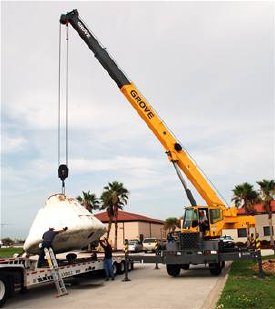Jul 4 2008
A relic from NASA's Apollo program was an eye-catching sight as it was transported via flatbed truck from its home July 1 at the Air Force Reserve's 920th Rescue Wing here to Port Canaveral.
 Workers help guide the 9,000-pound Apollo Boilerplate #1206 capsule onto a flatbed truck for transportation to a local refurbishment facility July 1 at Patrick Air Force Base, Fla. On loan here to the Air Force Reserve's 920th Rescue Wing from the Smithsonian Institute's Air and Space Museum, the capsule was once used by Air Force rescue units to train for astronaut recovery during the Apollo and Skylab space programs. (U.S. Air Force photo/Capt. Cathleen Snow).
Workers help guide the 9,000-pound Apollo Boilerplate #1206 capsule onto a flatbed truck for transportation to a local refurbishment facility July 1 at Patrick Air Force Base, Fla. On loan here to the Air Force Reserve's 920th Rescue Wing from the Smithsonian Institute's Air and Space Museum, the capsule was once used by Air Force rescue units to train for astronaut recovery during the Apollo and Skylab space programs. (U.S. Air Force photo/Capt. Cathleen Snow).
The white, 11-foot by 13-foot, 9,000-pound space capsule, on loan to the 920th Rescue Wing from the Smithsonian Institute's National Air and Space Museum, has been kept here since 1992 and is in need of restoration.
It was moved about 12 miles up State Route A1A through Cocoa Beach and Cape Canaveral to Excell Coatings Inc. at Port Canaveral, where it will spend the next month being refurbished.
Smithsonian officials said they are pleased with the restoration project and are happy to renew the loan agreement for the capsule, said Darrell Hankins, the resource adviser for the 920th Rescue Wing.
The capsule, listed in the Smithsonian's Web database as: "Boilerplate, Command Module, Apollo, #1206," was used in England by U.S. Air Force rescue members in the 67th Aerospace Rescue and Recovery Squadron at Royal Air Force Woodbridge to train in recovery operations for both the Apollo and Skylab programs.
Officials from the 920th Rescue Wing provide emergency medical, rescue and recovery support for all space shuttle and rocket launches. Unit members will assume an even-more prominent role in NASA's next manned-spaceflight venture, the Constellation program, scheduled for initial launch in 2014. Wing pararescuemen and aircraft will be responsible for tracking and retrieving astronauts from space capsules that will parachute into the ocean upon return from space, as was the case with manned spaceflight until the onset of the space shuttle program.